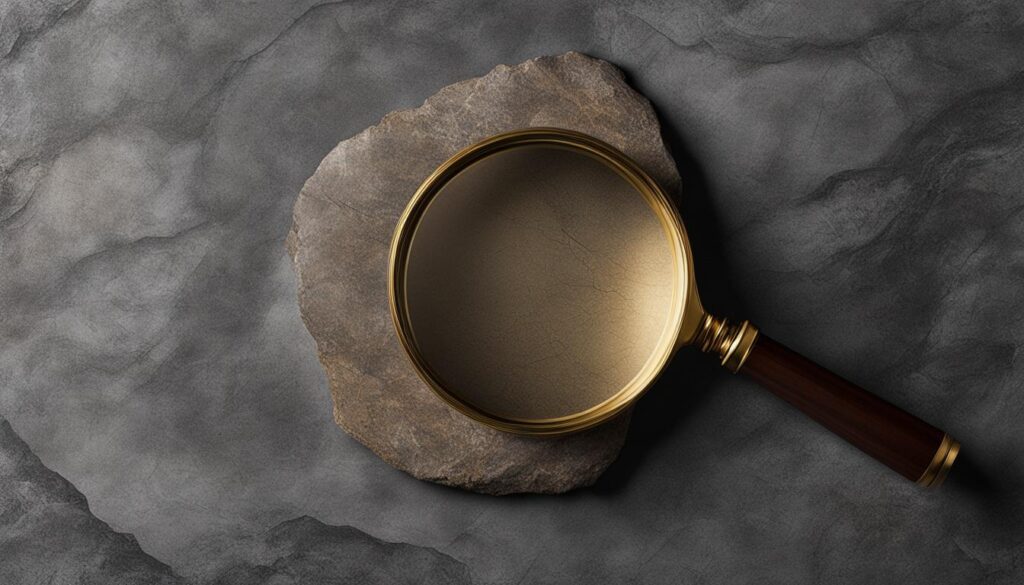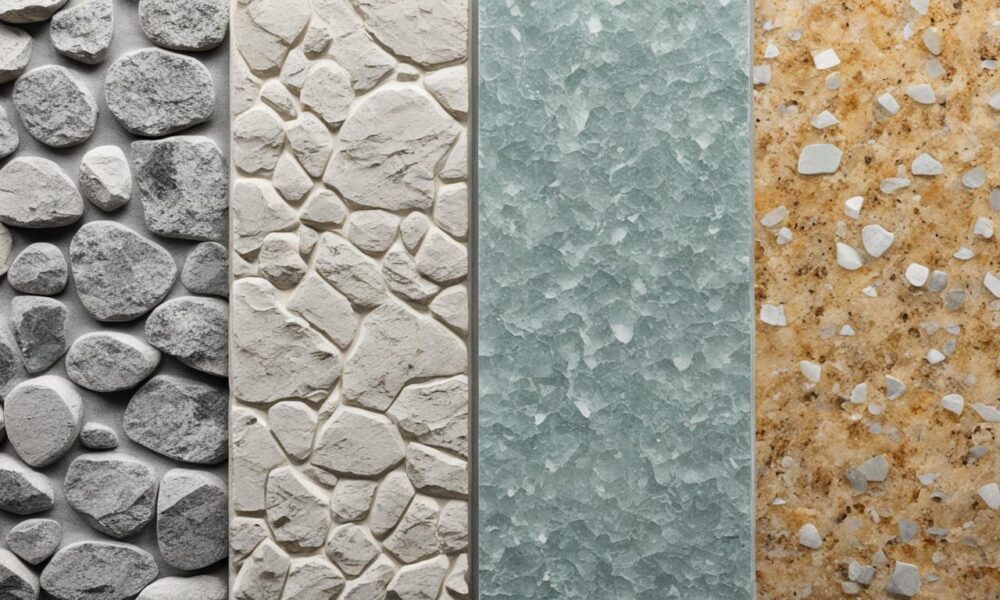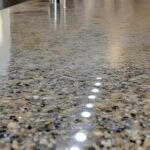Identifying Counterfeit Natural Stone – Expert Tips
With advancements in technology, some stone manufacturers have been able to create quality knock-offs of granite, marble, and other natural stone types. However, genuine natural stone offers unparalleled hardiness, scratch resistance, heat resistance, and beauty. Here are six tips to help you determine whether the stone you are looking at is fake or real.
Key Takeaways:
- Counterfeit natural stone can closely resemble the real thing, but it lacks the durability and unique characteristics of genuine stone.
- Pricing can be a clue to identify fake stone, as genuine natural stone is generally more expensive than imitation materials.
- The sound test involves tapping the stone to listen for a ringing feedback sound, which indicates authenticity.
- Examining the color and patterns of the stone can reveal whether it is naturally occurring or man-made.
- A water absorption test can help determine if the stone is porous and therefore natural, or non-porous and likely artificial.
Pricing as an Indicator
Genuine natural stone is typically more expensive than laminate, timber, or stainless steel countertops. Engineered stone materials cost around $350-$550 per square meter, while natural stone like granite or marble starts at around $500 per meter, with rarer stone slabs priced at over $1,200 per square meter. The price can be an indicator of whether you are looking at fake or real stone.
When shopping for natural stone, it’s important to consider the pricing as a factor in determining authenticity. While there can be variations in pricing due to factors such as geographical location and availability, significantly lower prices should raise a red flag. Fake or imitation stone often comes at a lower cost, mimicking the appearance of natural stone but lacking its inherent quality and durability.
By comparing prices across various suppliers and understanding the average cost of natural stone in your area, you can gain insights into the authenticity of the stone that you are considering. It’s essential to be wary of deals that seem too good to be true, as they may indicate the presence of counterfeit or lower-quality materials.
Keep in mind that pricing alone should not be the sole determining factor, as there can be legitimate reasons for variations in cost. It’s important to consider other indicators of authenticity, such as visual inspection, texture, and pattern analysis, to ensure you are investing in genuine natural stone.
| Type of Stone | Average Price per Square Meter |
|---|---|
| Engineered Stone | $350-$550 |
| Granite or Marble | $500+ |
Sound Test
When it comes to determining the authenticity of natural stone, one effective method is the sound test. By tapping the back of the slab using a light hammer or a piece of metal, you can listen for distinct sounds that reveal the true nature of the stone. Real natural stone produces a ringing feedback sound, which is a result of the reverberation of the natural rocks and minerals within. On the other hand, fake granite emits a duller and more muted clicking sound.
By utilizing this simple sound test, you can gain valuable insights into the authenticity of the stone before making a purchasing decision.
Color and Patterns
Genuine natural stone slabs have unique patterns and variations, making each piece one-of-a-kind. When assessing the authenticity of a stone, it is important to carefully examine the color and patterns present.
Look for slight variations in veins and texture, as these “imperfections” are indications of genuine stone. Genuine natural stone exhibits a beautiful and organic arrangement of colors and patterns, reflecting the uniqueness of nature.
On the other hand, fake or engineered stone often has repeating patterns and identical coloring throughout. These uniform patterns may lack the depth and complexity found in genuine stone, resulting in a less visually appealing appearance.
Unusually bright or bold colors may also indicate a man-made stone. Natural stone tends to exhibit more subtle and muted tones, while imitation stone may have vibrant or unnatural hues.
By assessing the color and patterns of a stone, you can gain valuable insights into its origin and determine whether it is real or fake.
| Genuine Natural Stone | Fake or Engineered Stone |
|---|---|
| Unique patterns and variations | Repeating patterns and identical coloring |
| Slight variations in veins and texture | No variations, uniform texture |
| Subtle and muted colors | Unusually bright or bold colors |
Comparison of Color and Patterns between Genuine Natural Stone and Fake or Engineered Stone
Water Absorption Test
Water can help identify the authenticity of natural stone. By conducting a simple water absorption test, you can determine whether the stone is genuine or engineered.
To perform the water absorption test, follow these steps:
- Obtain a few drops of water.
- Apply the drops of water to the surface of the stone.
- Observe the reaction of the stone.
If the stone is genuine natural stone, it will momentarily darken in the specific area where the water was applied. This darkening occurs due to the porous nature of natural stone, which allows it to absorb the water. On the other hand, if the stone is engineered, it is designed to be non-porous and will show no absorption or change in color during the water test.
The water absorption test is an effective way to distinguish between genuine natural stone and engineered imitations. It is important to note that this test should be used as one of several methods for identifying the authenticity of stone, and professional expertise is recommended for accurate assessments.
Inspecting Seams
When assessing the authenticity of stone countertops, one crucial aspect to consider is the examination of seams. By closely inspecting the seams, you can identify whether the countertop is made from genuine stone or if it is a fake imitation.
“The careful observation of seams can reveal valuable clues about the origin of the stone.”
Real stone countertops, even with meticulous installation, will exhibit visible differences in texture and pattern along the seams. These variations are a result of the natural characteristics of the stone and the way it is formed. On the other hand, engineered stone countertops will display a consistent pattern with no changes in nuances along the seams. In some cases, manufactured materials may not have seams at all, further indicating their non-natural composition.
By carefully assessing the seams of stone countertops, you can spot any inconsistencies that may indicate a fake. Whether you plan to purchase granite, marble, or any other type of stone countertop, this examination is a valuable step in ensuring that you make an informed decision.
Choosing a Reputable Supplier
When it comes to purchasing natural stone for your project, selecting a reputable and honest supplier is of utmost importance. A reliable supplier not only ensures the authenticity of the stone but also offers a wide range of options to meet your specific requirements. With their expertise and guidance, you can find the perfect natural stone materials to bring your vision to life.
Deluxe Stone is a trusted supplier that has built a solid reputation in the industry. They understand the value and beauty of genuine natural stone, and their commitment to quality is evident in their wide selection of authentic stone types. Whether you’re looking for granite, marble, or any other stone variety, Deluxe Stone has the expertise and inventory to cater to different budgets, styles, and applications. They prioritize customer satisfaction and go the extra mile to ensure you receive premium products that meet your expectations.
By choosing a reputable supplier like Deluxe Stone, you can rest assured that you are getting the real deal. Their commitment to honesty and integrity sets them apart in the market, making them the go-to choice for discerning customers who value authenticity and quality above all else.

The Importance of Choosing the Right Supplier
The success of your project depends on the quality of the materials you use. Working with a reputable supplier not only guarantees the authenticity of the natural stone but also provides several other benefits, such as:
- Access to a wide range of high-quality stone options
- Expert guidance and support throughout your selection process
- Assurance of ethical sourcing and responsible manufacturing
- Reliable delivery and excellent customer service
When you choose Deluxe Stone, you are choosing more than just a supplier. You’re choosing a partner who will help you make informed decisions and create stunning, durable spaces that stand the test of time.
Introduction to Spotting Fake Granite Countertops
Granite countertops have gained immense popularity in kitchens and bathrooms due to their durability, elegance, and timeless beauty. However, with the rising demand, the market has also seen an influx of counterfeit or fake granite countertops. It is crucial to equip yourself with expert knowledge to distinguish between real and fake granite countertops, ensuring you make an informed decision for your home.
When shopping for granite countertops, there are several key indicators and tests that can help you spot the authenticity of the stone. By paying attention to the following aspects, you can confidently identify genuine granite and avoid falling prey to fraudulent or low-quality alternatives:
1. Visual Inspection
Examine the granite closely, looking for natural variations and patterns that are unique to authentic granite. Genuine granite often displays a wide range of colors and veining, while fake granite tends to have a more uniform appearance.
2. Physical Feel
Run your hand over the surface of the granite to assess its texture. Authentic granite will typically have a slightly rough or granular feel, as it is a naturally occurring stone. In contrast, fake granite may feel unnaturally smooth and uniform, lacking the natural inconsistencies and imperfections that genuine granite possesses.
3. Water Absorption Test
Conduct a simple water absorption test to determine the porosity of the granite. Place a few drops of water on the surface of the countertop and observe how the granite reacts. Authentic granite, being a porous material, will absorb some amount of water, causing the area to momentarily darken. On the other hand, fake granite, often made of non-porous materials, will resist water absorption, resulting in no significant color change.
4. Acid Test
It is essential to exercise caution when attempting an acid test. Apply a small amount of mild acid, such as vinegar, to an inconspicuous area of the countertop. Authentic granite should not react or show any signs of etching or discoloration. However, fake granite may exhibit a negative reaction, such as fizzing or discoloration, indicating that it is not genuine.
5. Professional Consultation
If you are unsure or want expert confirmation about the authenticity of a granite countertop, seek professional assistance from reputable suppliers, stone fabricators, or geologists. These experts have extensive knowledge and experience in the field and can provide valuable insights to help you make an informed decision.
Now that you are equipped with these expert tips, you can confidently navigate the market and identify genuine granite countertops that will add timeless beauty and value to your home.
Price and Pattern Analysis
Genuine granite countertops are known for their timeless beauty and durability. However, distinguishing real granite from imitation materials can be challenging. In this section, we will explore two key factors to help you make an informed decision when selecting granite countertops – price and pattern analysis.
Examine Price
The cost of granite countertops can vary significantly based on several factors, including the type of granite, its origin, and the quality of the stone. Genuine granite tends to be relatively expensive due to the extensive extraction, transportation, and fabrication costs involved. High-quality granite slabs can range from $60 to $200 per square foot, excluding installation. Be cautious of significantly lower-priced countertops, as they may indicate the use of imitation materials.
Study Pattern
One of the distinctive features of genuine granite is its unique patterns and variations. Each granite slab has its own intricate design, formed by the natural minerals and geological processes that occurred over millions of years. Real granite exhibits a wide range of patterns, including veins, swirls, speckles, and color variations, making each countertop a unique work of art. On the other hand, fake granite countertops often have a more uniform and repetitive pattern, lacking the natural beauty and individuality of genuine granite.

When considering granite countertops, take the time to observe and appreciate the depth and complexity of the pattern. Look for subtle variations and irregularities that are characteristic of natural stone. These variations not only enhance the aesthetic appeal of the countertop but also serve as a testament to its authenticity.
By examining the price and studying the pattern of granite countertops, you can better distinguish between genuine granite and imitation materials. Investing in authentic granite will not only add timeless beauty to your space but also ensure the long-lasting durability that natural stone is known for.
| Features | Real Granite | Fake Granite |
|---|---|---|
| Price Range | $60 – $200 per square foot | Significantly lower prices |
| Pattern | Unique and varied | Uniform and repetitive |
| Aesthetic Appeal | Natural beauty and individuality | Lack of natural variation |
| Durability | High scratch and heat resistance | Lower durability |
Texture and Water Absorption Test
Genuine granite countertops have a slightly rough texture, while fake granite may feel unnaturally smooth and uniform. One way to assess the authenticity of granite is to feel its texture. Run your hand across the surface of the countertop and pay attention to the sensation. Genuine granite will have a subtle roughness that comes from the natural minerals and crystals embedded within the stone. In contrast, fake granite countertops, which are usually made from synthetic materials, tend to have a smoother and more consistent texture.
Another method to differentiate between real and fake granite is the water absorption test. This simple test can be conducted at home using some water and a clean cloth. Wet the surface of the countertop with a few drops of water and observe how the granite reacts.
“Feel the texture and conduct the water test to determine the authenticity of your granite countertops.”
Genuine granite is somewhat porous and will absorb water to some degree. You may notice a slight darkening or discoloration of the granite in the specific area where the water was applied. This is a natural characteristic of granite due to its porosity. However, well-sealed granite countertops will resist water absorption, with minimal to no change in color.
On the other hand, fake granite countertops, which are typically made from non-porous materials, will show little to no absorption or change in color during the water test. The water will bead or simply sit on the surface without being absorbed.
By combining the tactile assessment of texture with the water absorption test, you can gain valuable insights into the authenticity of your granite countertops.
Continue reading to learn more about stain resistance and performing a scratch test on your granite countertops to further authenticate their quality and durability.
Stain Resistance and Scratch Test
One of the key characteristics of authentic granite countertops is their impressive resistance to stains and spills when properly sealed. This is a testament to the durability and longevity of genuine granite. On the other hand, fake granite countertops may be more susceptible to staining, making them less desirable for high-traffic areas like kitchen countertops.
To assess the stain resistance of a granite countertop, you can perform a simple test by placing a few drops of common household liquids, such as coffee, red wine, or oil, on the surface. Allow the liquids to sit for about 10 minutes, then wipe them away with a damp cloth. Genuine granite should show minimal to no visible staining, while fake granite may leave behind noticeable discoloration.
The scratch test is another effective method to determine the authenticity of granite. Real granite is known for its remarkable hardness and scratch resistance, making it an excellent choice for countertops. To perform the scratch test, use a small piece of metal or a key to gently scratch the surface of the countertop. Genuine granite will withstand the test and show minimal to no visible scratches. Conversely, fake granite may display scratches more pronouncedly, indicating a lower level of hardness and authenticity.
By assessing the stain resistance and performing the scratch test, you can gain valuable insights into whether the granite countertop you are considering is authentic or not. These simple tests allow you to make an informed decision and choose a countertop that will not only enhance the beauty of your space but also withstand the demands of everyday use.
Conclusion
Identifying genuine gemstones in a market flooded with synthetic and imitation stones can be challenging. However, with the right knowledge and tools, gemstone authentication is possible.
When assessing the authenticity of gemstones, visual inspection plays a crucial role. Look for distinct physical characteristics such as color, clarity, cut, and carat weight. Genuine gemstones often display natural inclusions and imperfections, which add to their uniqueness and value.
Physical measurements can further aid in gemstone authentication. Precise measurements of dimensions, weight, and refractive index can provide valuable insights into the stone’s identity. Additionally, seeking professional expertise and consulting reputable gemstone laboratories can ensure accurate gemstone authentication.



